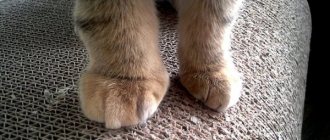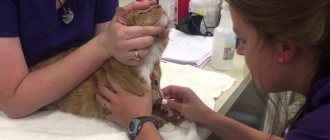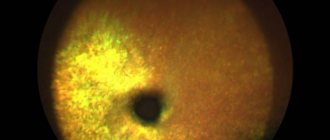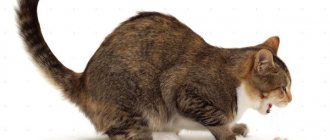Description
It is absolutely clear that without any special reason, a lump does not appear on a cat’s neck under the jaw. However, some cat owners, having discovered such a formation in their pet, are in no hurry to show it to a specialist and do not take any action to treat it. In rare cases, a lump on a cat’s neck may disappear on its own without treatment, but you should not let the development of such a formation take its course and you should consult a specialist as soon as possible.
The formation of any compaction or tumor is a consequence of a certain pathological process occurring in the animal’s body. Such a compaction can be either benign or malignant. However, even a harmless formation under the influence of certain factors can develop into a cancerous tumor.
Externally, the lump looks like a round or oval compaction that stands out from the rest of the skin with a reddish tint. It is easily detected by palpation. The density of a lump on a cat’s neck depends on its location:
- If the seal is between the muscles and the skin, it will be soft and mobile.
- The lump located in the muscle layers will be harder and more immobile.
According to medical terminology, such growths or lumps are called lipomas. Those of them that are close to the skin can be eliminated very simply through surgery. However, if the lipoma is deeper and develops very actively, then its treatment will be more difficult. There is no point in delaying therapy, because such a lump can very quickly degenerate into a malignant one - liposarcoma, which can metastasize to nearby organs.
It is impossible to determine the nature of the seal by its appearance, since it may be a common wart. Such formations can be quite large in size, however, the cat often does not experience pain. Without timely treatment, the lump develops very quickly and begins to interfere with the animal, and its attempts to independently get rid of the interfering seal can only worsen the situation.
Lipoma
Lipoma is a benign formation that can appear on any part of the animal's body. It is capable of growing, reaching impressive sizes, but does not cause pain to the cat and does not metastasize to other organs.
The lipoma is soft to the touch and has clear boundaries. Symptoms depend entirely on its location and the mechanical pressure on the surrounding tissues.
Despite the fact that a lipoma is practically harmless, when it forms on the limbs, it can cause lameness, and if located on the carotid artery, it can lead to the death of a cat from suffocation.
The condition of an animal that has developed a lipoma is usually normal and does not cause discomfort.
Lump as a reaction to the vaccine
If, after vaccination, swelling appears on the animal’s withers, most likely this is a natural reaction to the vaccine and there is no point in worrying. In this case, there is slight swelling and redness at the injection site. The main causes of post-injection bumps are:
- individual intolerance to the components of the drug;
- age (over 7 years) or overweight cat;
- belonging to a certain breed (hairless purebred cats tolerate vaccination more difficult);
- incorrect administration of the vaccine;
- using an unsterile needle;
- poor choice of injection site.
In most cases, this reaction does not cause concern to the animal and goes away after some time. Treatment is usually not required, but an alcohol compress can be used to speed up the distribution of the vaccine.
Possible consequences.
Complications after vaccination are quite rare, but nevertheless occur in a number of cases.
It is necessary to contact a veterinarian if:
- the lump turned very red and began to grow;
- the animal’s temperature rises above +39⁰C for several days;
- after a month, the swelling did not disappear or became denser;
- pressing on the lump causes pain for the pet;
- baldness of the skin around the vaccination site was detected.
Complications after vaccination can manifest themselves in the form of an abscess (a cavity filled with purulent fluid) and sarcoma (a malignant tumor).
Causes
In the vast majority of cases, a lump on a cat’s neck occurs in old age. Most veterinarians attribute this to the aging process of the animal's body. However, there are cases when owners discovered a large lump on the neck of a cat whose age did not exceed 5 years. The reasons for this can be very different. The main prerequisites for the occurrence of a pathological neoplasm include:
- bad ecology;
- eating low-quality products;
- predisposition at the genetic level;
- injuries or severe bruises;
- the presence of subcutaneous mites in the body.
Bump on a kitten's withers
In small kittens, swelling on the neck may appear after receiving the rabies vaccine. Kittens begin to be vaccinated at 3 months of age and then annually. Most often, such a small bump goes away within 14 days.
But there are cases when swelling serves as a signal for the development of a severe allergic reaction, which can result in anaphylactic shock. It is not recommended to leave the hospital immediately after this vaccination. It is better to observe the condition of the kitten within the walls of the veterinary hospital for half an hour.
Signs of lipoma
A lump on a cat's neck forms between the muscle layer and the skin layer. There the formation of nodules or capsules occurs. Most often, the contents of such capsules have a liquid consistency. It can be “doughy” and mobile, not causing discomfort to the animal, or it can be denser and cause pain. Subcutaneous formations may also include degenerated tissue.
The temperature of the soft cone most often corresponds to the cat's body temperature. Dense buds are usually hotter. If an initially soft formation has become compacted, the temperature of the animal’s entire body may rise and signs of intoxication of the body may appear. These signs include the following: the cat becomes weaker, refuses to eat, and becomes irritable.
Particular attention should be paid to buds that grow quickly.
Risk group
As stated above, older cats are most likely to develop lumps on their necks. At the same time, there are the following risk factors that can cause the development of such formation in younger individuals:
- the presence of endocrine disorders;
- the presence of parasites in the body;
- excess body weight.
Only a veterinarian can accurately determine the cause of the development of a lump under a cat’s neck. He also prescribes a treatment regimen, since it is strictly forbidden to independently treat any formations on the animal’s body.
Abscess
Also, in a cat, a lump on the neck under the skin may be an abscess. In this case, the lump will be filled with pus. Most often, an abscess appears at the site of a wound or injury. It can also be the result of exposure to parasites that irritate the animal's skin.
Main symptoms of an abscess:
- the formation has a homogeneous structure;
- the temperature rises and the skin surrounding the affected area turns red;
- pressing on the formation causes pain to the cat.
Due to the fact that such a bump causes discomfort to the cat, he always tries to scratch it. If he cannot reach with his paws, he rubs the sore spot on the furniture.
By its nature, an abscess is a purulent inflammation, so as a result of its development, the pet begins to feel worse. The cat becomes either lethargic or too irritable, refusing to contact the person.
Diagnostics
If a tumor appears in your cat's neck, you should immediately visit a veterinarian, since after a certain point it may rupture. In addition, if the lump reaches a large size, it can lead to suffocation.
After conducting a professional examination and certain studies, the veterinarian will be able to determine the nature of the formation and prescribe a course of treatment. As research, radiography and puncture biopsy of the contents of the lump are often performed. X-rays can reveal the presence of metastases, and a biopsy helps determine the nature of the compaction. The further treatment of the cat depends on the results of these two procedures.
A biopsy is performed by removing pathological materials from the formation. Before pumping out part of the contents of the lump, the cat is given local anesthesia. The sample taken is sent to the laboratory for cytological examination. Based on the results of this study, the doctor makes a diagnosis and, if necessary, prescribes surgery to excise or completely remove the formation.
Mastitis
A nursing cat may develop mastitis or mastopathy; often this disease is associated with the fact that the animal freezes while feeding outside. Mastitis can also be caused by non-nursing cats taking contraceptives. Lumps in the chest area sometimes grow quite large, they are painful, and can also cause fever and fever. Accompanying symptoms also include vomiting, diarrhea, and refusal to eat.
But veterinarians know how to cope with such a complication. The owners are only required to strictly comply with all the prescriptions of the course of treatment.
Treatment of abscesses
Before the lump on the cat's neck bursts, you should immediately begin treatment. In this case, only a veterinarian can help.
There is no preliminary treatment for such an abscess. After the examination, the cat is immediately sent to the surgeon. He opens the seal with a scalpel and cleans the cavity of pus. After this, antiseptic treatment of the wound is carried out. If necessary, the cat is given stitches and prescribed antibiotics to prevent the re-development of inflammation.
If left untreated, the abscess can open on its own. However, this is very dangerous for the animal, since it can lick the pus flowing from the wound. In addition, there is a high risk of infection.
Is vaccination necessary?
Pets practically become members of the family. It is important that they maintain their health. However, there is always a risk of contracting dangerous diseases. Vaccinating your cat is a reliable and time-tested means of eliminating this risk.
However, in this case, temporary complications can sometimes occur. Vaccination is the infection of an animal with weakened pathogens, which it can easily cope with and develop immunity to this disease. This procedure protects not only the pet, but also its owner from serious dangers.
ATTENTION! If a cat experiences temporary complications, the caring owner is obliged to do everything possible to alleviate his suffering.
Sometimes it seems that by following a certain regime for a cat, you can guarantee the absence of infection. However, in reality it is impossible to completely avoid this danger. Even keeping a cat in an apartment does not guarantee its safety. Pathogenic microorganisms can be brought into the home, for example, on shoes.
Vaccination is necessary for the following reasons:
- Rabies is a deadly disease. Vaccination protects against it. But if this is not done, the animal may become infected and die.
- A sick pet becomes dangerous to other animals.
- A cat with rabies can infect humans with this deadly disease.
After the vaccination procedure, the risk of contracting an animal with rabies is completely eliminated.










